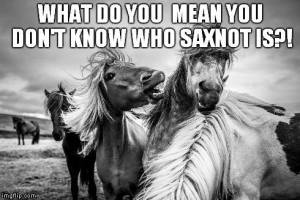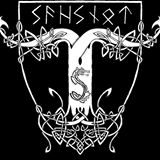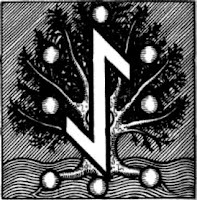by Týra Alrune Sahsnotasvriunt
The ancient Germanic and Norse tales of Gods and Alben, Giants and heroes, of mortal pathos mirrored by divine beings, in other words lore with all it includes and represents, is based on creative observations of nature and its elements.
Fire can be fickle and deadly but without the fire, the light of the sun, our worlds would be fast into darkness and annihilation.
The ocean grants us food and other treasures. It can also turn into a watery grave.
We are grateful for the air we breathe, pleasant fragrances, but are the unsuspecting victims of air-borne viruses or chemtrails.
Earth is our great nourisher, yet the price of living on it is to return into it – our Mother Jord – someday.
Sahsnotas was the embodiment of all the four elements. He was Skyfather, Sunfather, Earthfather and Oceanfather. He was not only the Lord and rider of the world yew tree he was our world, our world was made up of his different character traits and features so to speak and we were a part of him as he was of us.
From Indo-Germanic Dieus to Germanic Tiuz
Originally, Indo-Germanic Dieus or Dyaus Pita(r) (“Father Sky”), the “blue God” was a sky and sun God mentioned in the Vedanta. He was father to Agni (the God of fire) and Ushas (the God of Dawn). He blessed the earth from his realm above, fertilizing it and securing the survival of his human children hence.
Dieus (Latin: Deus, “the God”) was known as Zeus Pater in Greece and Macedonia
and as Gebeleizis by the Geto-Dacians and Thracians who also settled in today’s Romania. In fact ziua means “day” in Romanian. The Romans called him Jupiter (“Ziu-Piter”)
As society changed, war, naval warfare and pillaging became central to the survival of the Northern European tribes. Thus spirituality changed as well.
The Skyfather was now a God of war, the Thing (moot/peoples’ gathering) and justice, known as Ziu, Ziw, Zius, Tiw, Tiuz, Teiwaz, Tiwaz by the different Germanic tribes and Týr by the Scandinavians.
Tiuz, Our Germanic Father-God and his many Names
Tiuz as Irmin
The people settling around the upper and middle Elbe River called themselves Irminones after their chief God and Father-God Irmin – “The Sublime”, a byname of Tiuz.
A subtribe of theirs, the Semnones (who settled in today’s Niederlausitz), had dedicated a holy grove to Irmin which only persons with their hands tied to their backs were permitted to enter. By this the Semnones demonstrated their complete faith in this God; they voluntarily and gladly subjugated themselves to him, not only metaphorically but literally.
In case a person foundered and fell they were not to get back to their feet again but crawl back out of the grove.
This was to signify that they accepted the blessings as well as the hardships of life, imposed by Irmin, the Allvaldi (The Supreme; literally the Allruler, who was also called Allfather).
The Goths hung the weaponry of besieged opponents of war from branches in holy groves to thank Tiuz for the victory and for the prosperity this victory meant for their people.
The Rhinelander people were amongst the first tribes to replace Tiuz with Wotan in the 1st century. Up until that time they, too, sacrificed white horses, Tiuz’ attribute animals, to him on special occasions.
Until the 6th century even the Norwegians still sacrificed the first prisoner of war to Týr-Tiuz who they considered “the noblest of all Gods”.
Tiuz as Ingvi
The North Sea-Ingvaeones thought of themselves as the offspring of the sky and sun God Ing, Ingvi or Yngvi.
He is the Lord of the Ing rune, symbolizing isolation, separation, looking into oneself and drawing strength from oneself in order to grow and prosper, storing of energy and generally the seed from which all life and creative force comes. If you look at the Ing rune you will see that it consists essentially of two Kenaz runes brought together, Kenaz being the rune of fire, the fire of the sun, creation. To look into yourself means to “be” in Ingvi completely, to draw strength from the truest you, the spark inside given by Ingvi.
Ing is also just another of the many bynames of the God Tiuz.
Yet corresponding with the societal structure, lifestyle and character of the Ingvaeones, Tiuz as Ingvi had yet the one or other characterizing trait than Tiuz did. There were differences in worship and religious holidays as well.
To the shore population Ingvi was a mixture between Tiuz the God of justice and Fro/Frey/Frikko (“The Lord”), also known as the Foal God to whom the boar, white horse, elk and stag were attributed. He was a gentle agricultural God with several features similar to the “Horned God” or “Green Man” of the Celts.
To the Ingvaeonic Vikings he was also the God of seafaring and war.
On a side note, if you ever looked at a bottle of German “Jägermeister”-schnapps you might have noticed that its logo is of a stag with rays of the sun radiating around its mighty antlers. This is very much how Ingvi used to be depicted – save for the crucifix above his head of course. Later the Christian church stole this image and gave it a different meaning of course, the stag is – in their synretic belief system – representative of their God, the antlers symbolizing his crown and omnipotence.
Tiuz as Sahsnotas (Saxnot, Saxneat)
The fierce and unruly warrior tribe of the Saxons, venerated Tiuz as Sahsnotas (sword-companion) in todays’ Hamburg, Schleswig-Holstein (Friesland), parts of Niedersachsen, Jütland (Denmark) and parts of the Netherlands.
He was depicted as riding on a white horse, (see “Holy Horse!” – Horses in the Germanic and Norse Traditions) wielding a sword and wearing a helmet in the shape of a boar’s head. The boar’s tusks were pointed skyward, giving the impression that he wore a “horned helmet”.
Saxnot, the Irmin, was the world creator, the Lord of the Yggdrasil world yew tree (see Yggdrasil – Yew not Ashtree) and all its seven (!) worlds.
The world was “Irminsul” – Irmin’s pillar – and its effgy stood in the middle of a cultic cult site somewhere around Paderborn, Düwelsnacken (devil’s neck) between Altenbecken and the Iburg, the Extern Stones, Eresburg or Iburg until the savage Karl the “Great” (Charlemagne) in his mad rage against everything Pagan, destroyed it completely.
Saxnot’s name is preserved in the Frankish abjuration formula of the Saxons: “I abdicate Thunaer, Uuoden and Saxnote and all devils who art with them”.
Widukind’s Rebellion for Sahsnotas against Charlemagne
772 to 804. Charlemagne entered Saxony with the intent to conquer the Saxons and drive them out of their homelands. Charlemagne’s army was mighty, but as soon as he turned his attention elsewhere the Saxons would return to their homes and slay the invaders mercilessly under the lead of Widukind (Waldkind, i.e. “forest child”). As our Saxon armies dwindled and more and more of our people converted to Christianity Widukind rode into the forest one day, asking himself whether he should yield and also convert to the Christian faith. He then – allegedly – had a vision that convinced him to abandon Sahsnotas and the faith in the Germanic Gods. Whether this is true or like any sane leader he decided to give in in order to save his people from certain death and outbreeding – we cannot know for certain.
Unfortunately several monuments in Germany are dedicated to him, the most famous one in Nienburg, and on each he is depicted with a Bible in hand.
Even after the official conversion of the Saxon tribes to Christianity though, many rebelled in secret, bloting to the Gods, celebrating the old holidays and keeping their traditions. This was continued until the “dark ages”.
So the Saxons were amongst the few ones that combated Christianity for as long as they possibly could, even after their “conversion”. Many of our Northern German traditions and holidays (see also https://paganmeltingpot.wordpress.com/2015/01/25/pagan-remnants-of-north-frisian-holiday-celebrations-and-customs-19th-21st-century/) are – to this day – essentially Pagan, even though they were given Christian names and meanings.
Tiuz the North Star, Axis of the World
Some sentiments about the North Star are as follows: It is the the pillar of the world,” “the star that keeps the world going round,” it is the “Skyfather” himself, as well as “the left hand of justice.” (>Týr). If you look at a depiction of the original Irminsul you will see that atop it, in the center, is an Ing rune-looking shape – the North Star.
Tiuz-Runes
Tiwaz
When asked which rune is most representative of Tiuz, many people will immediately name theTiwaz rune. And of course it has some resemblence to the Irminsul itself, an Isa (stability) on which a Kenaz pointed upwards is “mounted” like a little iron battle helmet.
Ing
Ing has been mentioned, two Kenaz’ coming together to shape a complete geometrical rhombus.
Sowilo
Sowilo, the rune of the sun and victory, dedicated to Tiuz as Ingvi-Fro.
Dagaz
As mentioned above Dyaus Pita(r) was the father of (the God of) dawn and day(light), in Romanian the word “ziua” means day and so does “Dagaz”.
Kenaz
Now, of course, Kenaz is commonly associated with fire God Loki, with Surtr as the King of Muspelheim or with any other fire giant. In some of these cases the fire becomes destructive, the fire of rebirth. In Tiuz’ case though it is simply the fire or force of light of creation.
Mannaz
Man. Though it is not specifically dedicated to Tiuz I include this rune as Ehwaz (the horse) and Mannaz are very similarly shaped for a reason. Tiuz rides the tree (all seven worlds) on his white horse and he “rides” us in our Shamanic travels as well. He “possesses” us and we live only according to Skyfather or rather according to all nature and the laws of the world tree.
Ehwaz
The (sacred white) horse. Tiuz-Saxnot as the rider of the world tree.
Eiwaz
Rune of the world yew tree Yggdrasil, which I have written about in length in my blog post about Yggdrasil the world yew tree.
Raido
Tiuz as the traveller, the rider.
The Swastika and Black Sun
The sunwheel, consisting of four Kenaz runes. To the right: The Black Sun.
Tuesday
Tiuz gave Tuesday its name. And Tuesday (as well as Woden’s day – Wednesday) were popular dates to hold the Thing, sign contracts and get married. According to Edwin Miller Fogel in his “Beliefs and Superstitions of the Pennsylvania Dutch” (1915) that the Pennsylvania Dutch still commonly chose Tuesdays and Wednesdays for above mentioned occasions.
He also writes that red is a color commonly associated with Tiuz, and what would make more sense if we consider that Kenaz, the fire of creation, the sun, are symbols of him.
Herbalism
Aconitum Napellus is the Latin term for an herb known as Wolfsbane in English or Himmelvatershelm (“Skyfather’s Helm”), Týr’s Helm or Eisenhut (“iron hat” reminiscent of the Tiwaz-rune) in German. If you paid attention then you will remember that Dyaus Pita(r) was associated with the color blue.
Now, before you excitedly go look for Eisenhut for any ritual to Tiuz-Saxnot or for any kind of Shamanic travel – it is extremely toxic. Ingesting it carelessly may very well lead to death. I suggest thoroughly studying herbology with a knowledgeable person before handling Eisenkraut.
In homeopathy Aconitum Napellus is used to treat the common cold, flus, coughs, chills and fever. Please also note that one should avoid self-medicating, even with homeopathic remedies that are often falsely described as inefficient, “weak” or pure humbug. If you are suffering from any disease or illness do consult a healer, homeopath or similar.
Sahsnotas wife?: Baduhenna-Frigg
Scholars have been arguing about who Baduhenna is for decades. We know of her only due to Tacitus who painted her as a Frisian or possibly Saxon Goddess. She possesses many traits of Frigg and is described as married to “the ruler God”. Due to the nature of her name she was most commonly believed to be a warrior Goddess, although there are voices trying to sell her as a guise of Wotan. Like so many other (possible) Goddesses – Tanfane, Zizu, Harke and many others, we hardly know anything about her. Any actual lore was lost, only clues remain.
Týr the Moral One – How the God lost his Oathing Hand
If you are a Germanic or Norse Pagan or a Heathen of some sort there is no chance you have not heard about the tale of Fenrir’s binding. It does not only illustrate nicely the struggle between the foces of stability (the Asen) against the foces of evolution (the giants) but could essentially be viewed as the tale of Týr’s morality.
In short – the Asen Gods decided that Loki’s child, the Fenriswolf, posed a threat to their rules or perhaps the balance between evolution and stability, as Fenrir was a mighty giant who was boundless in his hunger. So they decided to bind him. The dwarves helped construct the bonds that might hold such a mighty creature and called it Gleipnir. It consisted of “everything impossible” – the sound of a cat’s footfall, the beard of a woman, the roots of a mountain, the sinews of a bear, the breath of a fish and the spittle of a bird.
The Gods approached Fenrir asking him if he would like to play a game to test his strength. Fenrir, already weary of the Gods since they had tried to bind him with ordinary chains twice before, agreed only if as a collateral Týr would place his hand in the giant wolf’s snout. Týr agreed. The chains held and thus Týr lost his hand.
Interestingly it is not specifically mentioned in the Eddas whether Tiuz knew what would befall him. This is a matter of drawing your own conclusions from your interpretation of lore and and of belief or “UPG” (unverified personal gnosis through prayer, meditation, ritual or other). If he did however as is commonly assumed, then – as Wotan sacrificed an eye for knowledge – Týr sacrificed his spear hand for the well-being of all the cosmos.
A Comparison between Tiuz and Wotan
As times changed, so did the Gods and some were replaced completely. Wotan must have seemed especially appealing to the Germanic tribes, they were rather quick to not just adopt him as they had so many other Gods or attributes of other tribes’ and culture’s Gods, they made them their chief God, the Walvater (ValFather), father of the line of Val, often translated as “Father of the Chosen Ones” but literally meaning “Father of Corpses”.
Wotan was a God that broke up social and spiritual conventions completely, which was desperately needed back then:
He was not only a God of war and death, he was so eager to gain knowledge that he sacrificed his own eye. He lied and deceived if necessary and according to Saxo Grammaticus he also had Rindr’s father tie her to her bed so he could rape her and produce the mighty Vali who would avenge Wotan’s death in Ragnarök. Whether this is true or simply the bloodthirsty accounts of a Christian monk we don’t know. Since this tale appears nowhere else it might just be another typical Christian trap to convince those few Pagans left to abandon Paganism.
Wotan was a rather “liberal” God by means of using “female magic” (Seid), something Loki accused him of in The Edda’s Lokasenna. He overcame the (artificial) boundaries and although he did things that – according to the standards back then – were rather shocking, were also impressive and brave.
Naturally, Wotan took over many of the attributes of the former chief and most beloved Gods, of Sahsnotas-Týr who’d hung himself from the world tree to receive the runes, of Frigga-Holle – head of the Wild Hunt, etc…
He was not only sly, though not as sly as his blood-brother Loki, but he was also fickle. This is why as much as he was loved and revered he was also feared by his worshippers.
And so Tiuz was made a son of Wotan, playing a minor role in the pantheon and the lives of people hence.
Last thoughts:
As much as we have to be grateful to Snorri Sturlason for providing the stories of the Eddas, they are neither reliable sources due to Snorri having been a devout Christian already, nor are they respresentative of non-Scandinavian polytheism. In Germany, we have our own lore, deeply embedded in folk- and fairy tales, often obscure(d) and with a lot left to guess thanks to violent Christianization. But enough historical sources are available to acknowledge that the beliefs of the ancient Scandinavian tribes are not ours. We have our own customs, Gods and beliefs. I hope that more Germans, Southern Danes and Dutch people will realize what treasures lie within their own tales and culture and draw strength and inspiration from them.
Sources:
Wolfgang Gother – Handbuch germanischer Mythologie
Heinz Löwe – Die Irminsul und die Religion der Sachsen (in: Aufsätze | Deutsches Archiv für Geschichte des Mittelalters – 5 | Periodika
Jakob Arnstadt – Die Frau bei den Germanen
Felix Dahn – Germanische Mythologie
E. Doepler D. J. und Dr. W. Ranisch – Walhall – Die Götterwelt der Germanen
Franz Kurowski – Die Sachsen, Schwertgenossen Sahsnotas
http://www.tyrsax.homepage.eu/
http://gimenitha-sahsnotas-threcwithi.de.tl/


















